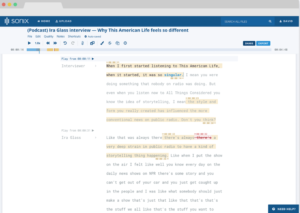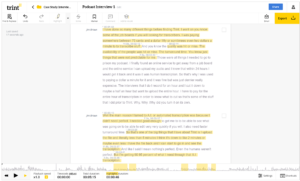Podcasts have exploded in popularity, with over half of Internet users now tuning in regularly. Their accessibility and ability to reach specialized audiences make them invaluable to content creators, brands and businesses alike. If you’re looking to expand beyond your home market, podcast audio translation is the key to reaching worldwide listeners. In this article, we’ll explore how to effectively translate your podcast for international success.
Step-by-step: How to effectively translate a podcast
Podcasts need to sound as natural as possible, so there’s no room for literal translations here. You’ll need a solid plan to ensure the quality and consistency of your content based on these key steps:
- Transcribe the original content: Before any translation begins, you need a reliable transcript of the episode. This lets you work with the text and ensures the translation stays true to the original message.
- Choose a translation method: You have two main options: machine translation with human editing, or professional translation services. For natural-sounding and precise results, professional services typically deliver superior quality.
- Decide on the translation format: There are two main options for translating a podcast:
- Subtitles: Translated subtitles for video podcasts on platforms like YouTube.
- Dubbing or voiceover: Recording voices in another language, which creates a more immersive listening experience.
- Record and edit the audio translation: If dubbing, invest in professional voice talent who can guarantee a quality listening experience.
- Publish and promote the translated podcast: Make sure to optimize the podcast’s title, description, and metadata for maximum discoverability on streaming platforms.
By following these steps, you can offer a translated version of your podcast that preserves the essence and impact of the original content.
Podcast translation tools
Several specialized tools can streamline your podcast translation workflow:
Descript
Descript is an audio editing software that offers automatic transcription and dubbing capabilities. It also includes powerful editing features that save time for content creators, such as the removal of filler words and silences, and increasingly natural, machine-learning-based dubbing in different languages.
Sonix
Sonix is a multi-language transcription tool that excels at translating audio content. Its platform offers real-time cloud editing and precise subtitle synchronization, making it the perfect option for those seeking both precision and speed.
Trint
Trint simplifies translation and editing by using AI to convert audio to text. Its intuitive interface allows users to review and modify the automatically generated transcripts, while its collaborative features let multiple editors work simultaneously, speeding up the translation and dubbing process.
Spotify’s AI Voice Translation
Spotify has launched a pilot program called AI Voice Translation, an AI-powered technology that translates and dubs podcasts into different languages. By preserving the intonation and characteristics of the original podcaster’s voice, the tool provides a more authentic experience for international audiences. Though limited to Spanish, French, and German for select creators now, expansion is expected in the near future.
While these tools can be a good starting point, it’s best to work with professionals if you want high-quality translations that truly resonate in other languages. At Linguaserve, we specialize in adapting content for international audiences, offering custom voiceover and dubbing services designed to meet your specific needs.
Practical tips for getting started translating your podcast
As you begin your translation journey, keep these tips in mind:
- Focus on strategic languages: Research your audience demographics and target high-potential markets rather than attempting to translate into every language. Also, consider the main language used on the platforms hosting your content.
- Adapt the cultural content: Effective translation isn’t just about words; it considers cultural context as well, making sure the message is relevant and understandable to the target audience. Avoid idioms or references that might confuse international listeners.
- Invest in quality: If you decide to dub your podcast, working with professional voice actors will take the listening experience to the next level, especially if you choose actors who match the tone and energy of the original hosts.
- Check synchronization: Whether using subtitles or dubbing, it’s important that the translation is well-synchronized with the original audio. A mismatch in synchronization can disrupt the listener’s experience and make the content feel unnatural.
- Optimize the podcast’s SEO: Use keywords in your titles and descriptions to improve discoverability on search platforms. You can also include keywords in the metadata and episode descriptions to help potential listeners find your content.
- Experiment with different translation formats: Not every method works for every audience. Try out subtitles, dubbing, or even original episodes in another language and see which format drives the most engagement.
- Gather listener feedback. When you release a translated episode, ask your audience to share their thoughts on the experience. This feedback can be tremendously helpful for improving and fine-tuning future translations.
Translating your podcast is the perfect way to expand your audience and connect with global audiences. With a clear plan, the right tools, and quality translation, your content can transcend language barriers and build an international community of listeners.
For creators serious about making this leap, professional translation and voice talent services make all the difference. At Linguaserve, we’re here to help you adapt your podcast for new audiences, whether you choose dubbing or subtitles. It’s time to share your voice with the world!





